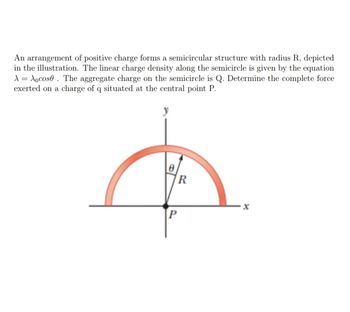
College Physics
11th Edition
ISBN: 9781305952300
Author: Raymond A. Serway, Chris Vuille
Publisher: Cengage Learning
expand_more
expand_more
format_list_bulleted
Concept explainers
Question

Transcribed Image Text:An arrangement of positive charge forms a semicircular structure with radius R, depicted
in the illustration. The linear charge density along the semicircle is given by the equation
A Xocose. The aggregate charge on the semicircle is Q. Determine the complete force
exerted on a charge of q situated at the central point P.
=
R
P
x
Expert Solution
This question has been solved!
Explore an expertly crafted, step-by-step solution for a thorough understanding of key concepts.
Step by stepSolved in 3 steps with 4 images

Knowledge Booster
Learn more about
Need a deep-dive on the concept behind this application? Look no further. Learn more about this topic, physics and related others by exploring similar questions and additional content below.Similar questions
- The figure below shows a small, charged bead, with a charge of q = +41.0 nC, that moves a distance of d = 0.174 m from point A to point B in the presence of a uniform electric field E of magnitude 255 N/C, pointing right. A positive point charge q is initially at point A, then moves a distance d to the right to point B. Electric field vector E points to the right. (a) What is the magnitude (in N) and direction of the electric force on the bead? magnitude Ndirection (b) What is the work (in J) done on the bead by the electric force as it moves from A to B? J (c) What is the change of the electric potential energy (in J) as the bead moves from A to B? (The system consists of the bead and all its surroundings.) PEB − PEA = J (d) What is the potential difference (in V) between A and B? VB − VA = Varrow_forwardA total amount of positive charge Q is spread onto a thin non-conducting circular annulus of inner radius a and outer radius b. The charge is distributed in a way so that the charge density per unit area is given by ? =??3, where r is the distance from the center of the annulus to any point on it and k is a constant.(a) Find an expression for the total charge Q on the annulus. (b) Find an expression for the potential V at the center of the annulus in term of Q, a and barrow_forwardA negative point charge Q1, is located at the origin. A rod of length L is located along the x axis with the near side a distance d from the origin. A positive charge Q2, is uniformly spread over the length of the rod. After integrating the force from each slice over the length of the rod, the magnitude of the electric force on the charge at the origin can be represented as the following: F = (k |Q1| |Q2|) / (d (d + L)) Let L = 2.22m, d = 0.42m, Q1 = -6.29µC, and |Q2| = 11.1µC. Calculate the magnitude if the force in newtons that the rod exerts on the point charge at the origin.arrow_forward
- A non-conducting rod of length a is uniformly charged with the total charge +Q, and the rod along the x-axis. A small charge +q is at some point X, on axis x. Find the electrostatic force that the rod exerts on the point charge. +Q +9arrow_forwardThe figure shows a configuration of putual charges that has the value of q1=-2e, q2=2e, q3=4e, q4=e, where e is the fundamental charge. The angle that the charge q1 makes with the negative x axis is θ1= 35.0o. Determine: a) The magnitude of the net force on the charge at the origin b) The angle of the net force on charge fourarrow_forwardThere are two uncharged concentric conducting spherical shells and a separate point charge. The smaller shell has an inner radius of 0.100m and an outer radius of 0.200m. The larger shell has an inner radius of 0.300m and and outer radius of 0.400m. A point charge of +10.0μC is placed between the two shells at a radius of 0.250m from the origin. Determine the net charge on each of the four surfaces (r = 0.1,0.2, 0.3, 0.4) and make a sketch that indicates BOTH the electric field lines and the surface charge densities. (this sketch does not have to be exactly mathematically correct, but use intuition)arrow_forward
arrow_back_ios
arrow_forward_ios
Recommended textbooks for you
 College PhysicsPhysicsISBN:9781305952300Author:Raymond A. Serway, Chris VuillePublisher:Cengage Learning
College PhysicsPhysicsISBN:9781305952300Author:Raymond A. Serway, Chris VuillePublisher:Cengage Learning University Physics (14th Edition)PhysicsISBN:9780133969290Author:Hugh D. Young, Roger A. FreedmanPublisher:PEARSON
University Physics (14th Edition)PhysicsISBN:9780133969290Author:Hugh D. Young, Roger A. FreedmanPublisher:PEARSON Introduction To Quantum MechanicsPhysicsISBN:9781107189638Author:Griffiths, David J., Schroeter, Darrell F.Publisher:Cambridge University Press
Introduction To Quantum MechanicsPhysicsISBN:9781107189638Author:Griffiths, David J., Schroeter, Darrell F.Publisher:Cambridge University Press Physics for Scientists and EngineersPhysicsISBN:9781337553278Author:Raymond A. Serway, John W. JewettPublisher:Cengage Learning
Physics for Scientists and EngineersPhysicsISBN:9781337553278Author:Raymond A. Serway, John W. JewettPublisher:Cengage Learning Lecture- Tutorials for Introductory AstronomyPhysicsISBN:9780321820464Author:Edward E. Prather, Tim P. Slater, Jeff P. Adams, Gina BrissendenPublisher:Addison-Wesley
Lecture- Tutorials for Introductory AstronomyPhysicsISBN:9780321820464Author:Edward E. Prather, Tim P. Slater, Jeff P. Adams, Gina BrissendenPublisher:Addison-Wesley College Physics: A Strategic Approach (4th Editio...PhysicsISBN:9780134609034Author:Randall D. Knight (Professor Emeritus), Brian Jones, Stuart FieldPublisher:PEARSON
College Physics: A Strategic Approach (4th Editio...PhysicsISBN:9780134609034Author:Randall D. Knight (Professor Emeritus), Brian Jones, Stuart FieldPublisher:PEARSON

College Physics
Physics
ISBN:9781305952300
Author:Raymond A. Serway, Chris Vuille
Publisher:Cengage Learning

University Physics (14th Edition)
Physics
ISBN:9780133969290
Author:Hugh D. Young, Roger A. Freedman
Publisher:PEARSON

Introduction To Quantum Mechanics
Physics
ISBN:9781107189638
Author:Griffiths, David J., Schroeter, Darrell F.
Publisher:Cambridge University Press

Physics for Scientists and Engineers
Physics
ISBN:9781337553278
Author:Raymond A. Serway, John W. Jewett
Publisher:Cengage Learning

Lecture- Tutorials for Introductory Astronomy
Physics
ISBN:9780321820464
Author:Edward E. Prather, Tim P. Slater, Jeff P. Adams, Gina Brissenden
Publisher:Addison-Wesley

College Physics: A Strategic Approach (4th Editio...
Physics
ISBN:9780134609034
Author:Randall D. Knight (Professor Emeritus), Brian Jones, Stuart Field
Publisher:PEARSON